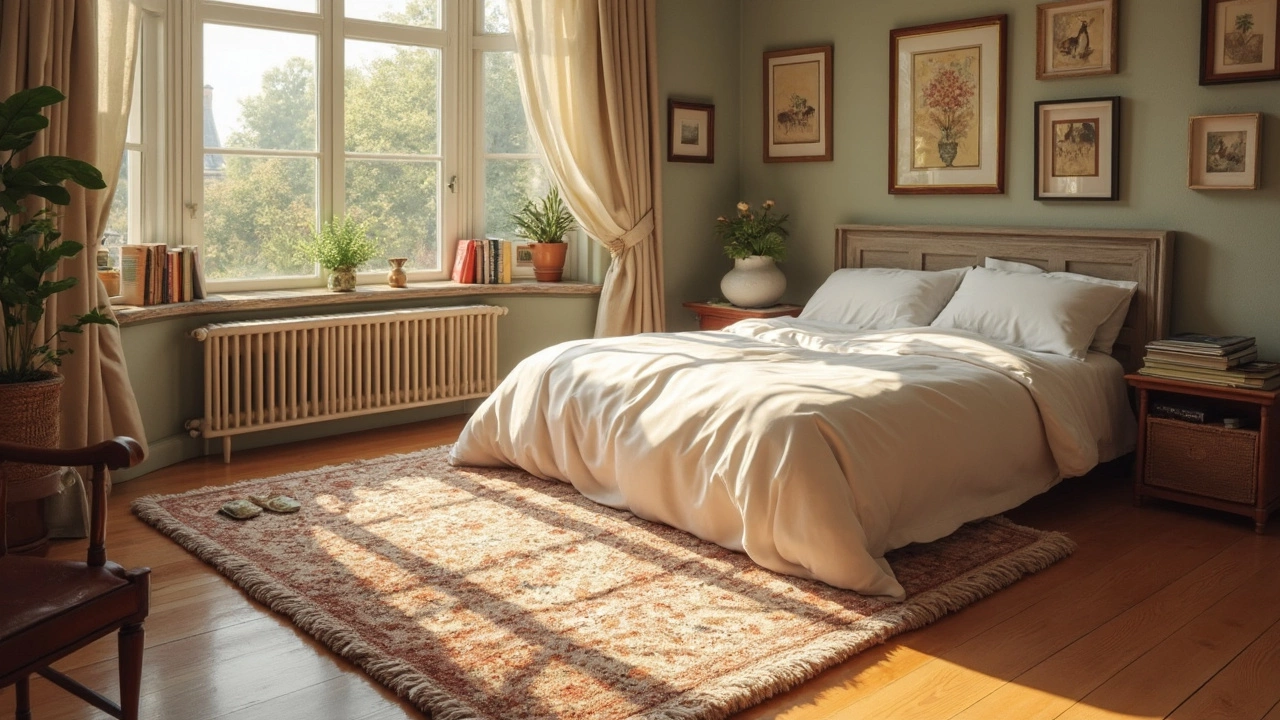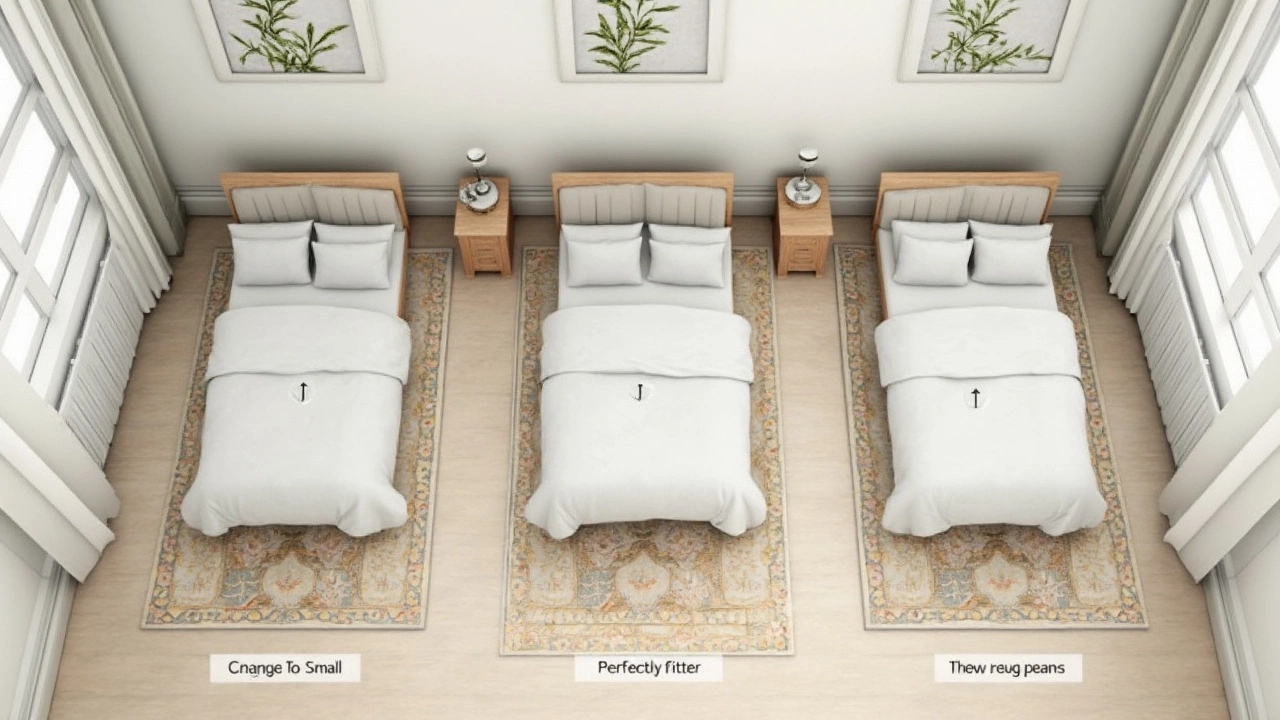Rug Under Bed: Why Bother?
 May, 10 2025
May, 10 2025
Tired of chilly feet first thing in the morning? A rug under your bed instantly solves that—no more cold hardwood or tiles when you roll out for the day. But the benefits don't stop there. Rugs can muffle footsteps, which is perfect if you've got light sleepers or cranky toddlers upstairs (I’ve been woken up by both Dorian and Selena running around more times than I can count).
Here’s the thing: a well-placed rug makes your sleep space way cozier and, honestly, it looks sharper, too. Even if your bedding or furniture isn’t top-of-the-line, the right rug underneath ties the whole room together. Suddenly, your basic bed feels more like a cozy retreat and less like a forgotten guestroom.
- Comfort and Warmth Boost
- Clever Style Hacks
- Noise Control and Room Flow
- Practical Rug Placement Tips
Comfort and Warmth Boost
Ever step out of bed onto a cold floor in winter? It’s the fastest way to wake up, but not in a good way. Putting a rug under bed banishes that freezing feeling—soft fibers underfoot make all the difference, especially first thing in the morning or in the middle of the night.
The insulation isn’t just about toes. Rugs add an actual layer between you and cold flooring. Check this out: According to the Carpet and Rug Institute, a quality rug can cut heat loss through floors by up to 10%, making the whole room feel warmer, without cranking up the heating bill.
| Floor Type | Surface Temp (ºF) Bare | Surface Temp (ºF) With Rug |
|---|---|---|
| Tile | 60 | 66 |
| Laminate | 64 | 69 |
| Hardwood | 62 | 67 |
If you’ve got kids who like to sprawl on the floor or play with toys right next to the bed (mine sure do), having a rug is a total win for comfort. It makes sitting, stretching, or kneeling more comfortable—nobody likes carpet burns or bruised knees from a wood floor.
For families with allergies, there’s even more: modern rugs can trap dust and allergens, keeping the stuff from floating around where you breathe. Just remember—you’ve got to vacuum regularly so the benefits stick around.
Clever Style Hacks
If your bedroom feels a little bland, throwing a rug under bed can really liven things up—without a total remodel. The right rug adds color, texture, and even makes the room look bigger if you get the size right. Designers say that when your rug sticks out at least 18-24 inches past each side of the bed, it pulls the furniture together and anchors the space. For king beds, go for an 8x10 or 9x12 foot rug; queen beds usually look good with an 8x10, and twins can get by with a 5x8.
Picking the right pattern matters too. If your bedding is mostly plain or just one color, grab a rug with a bold print or rich color for contrast. But if you love patterned comforters—like those ones with dinosaurs or rainbows my kids always pick—then a simple, solid-color rug keeps things from clashing. Texture makes a difference as well: a shaggy rug feels great underfoot, while a flatweave looks neat and won't collect as much dust.
For smaller bedrooms, try sliding the rug under just the bottom two-thirds of the bed and leaving the headboard area bare. It saves you money since you won’t need as big of a rug, but you still get all the style benefits. And if your room shape is unusual, don’t stress—layering two smaller rugs at angles or using a round rug at the foot of the bed can look intentional and create a relaxed, lived-in feel.
- Match rug colors to a few accents—like throw pillows or wall art—to make the decor feel planned, not random.
- If you rent and want a quick update, try a peel-and-stick rug pad underneath; it keeps the rug in place and comes off easy when you move.
- Don’t forget, high-pile rugs (the fluffy ones) work better in low-traffic rooms. If your pets or kids constantly run through, pick a low-pile or flat rug for easier cleaning.

Noise Control and Room Flow
A rug under bed isn't just about looks. It actually makes your bedroom quieter. Thick rugs and padding absorb sound, so you hear less thumping, talking, or TV noise from nearby rooms or someone walking above you. This can be a real lifesaver for parents, night owls, or anyone who shares walls or floors with others.
A University of Salford study out of the UK found that carpeted flooring can reduce noise by up to 30 decibels compared to hard surfaces. That’s the difference between a gentle conversation and a loud dishwasher. If you’ve ever tried to sneak to the bathroom at 2 a.m., you’ll get it—carpet helps keep your steps silent.
Besides noise, rugs change how the room feels. They break up big spaces and connect furniture, so the room flows better. Your eye naturally follows the shape of the rug, making the layout feel more intentional. This matters more in bedrooms with odd shapes or furniture that’s spaced out.
- Place the rug so it extends past the bed on both sides for walking comfort and balanced design.
- If your bedroom is large, use an oversized rug to anchor the bed and nightstands—no one likes tiptoeing onto the cold floor.
- In smaller rooms, try a runner on both sides or at the foot of the bed for noise reduction without crowding the area.
| Surface Type | Noise Absorption (Reduction in decibels) |
|---|---|
| Hardwood | 5-10 dB |
| Thin Area Rug | 10-15 dB |
| Thick Rug with Pad | 25-30 dB |
So, the right rug can mean quieter mornings and a bedroom that just makes sense when you walk in. You’ll notice the difference with every step—and every little bit of quiet counts, especially if you live with kids, pets, or both.
Practical Rug Placement Tips
If you're wondering how big your rug should be, it depends on your bed size—and the trick is simple. For a king or queen bed, shoot for a rug that's at least 8x10 feet if you want it to peek out nicely on all sides. For twin beds or smaller rooms, a 5x8 rug usually does the job without crowding the furniture.
Here's a tip I wish I'd heard sooner: don't jam a tiny rug under the bed. It just looks awkward and gets lost under the frame. You want that soft landing spot for your feet when you get in and out of bed, but also a chunk of the rug showing around the sides and bottom. A good rule is to leave about two-thirds of the rug under bed, letting the rest extend into the space where you step.
- Want a custom feel? Place runners (long, narrow rugs) on either side instead of a big one underneath, especially if your bedroom is smaller or you want to change up the look.
- Make sure your nightstands are either completely on or completely off the rug—never halfway. This avoids that lopsided, unplanned vibe.
- Leave about 18”-24” of floor showing around the rug edges if your room allows, so things don’t look too cramped or crowded.
- If you have a bed with a bench at the foot, it looks polished if both the bed and bench sit on the rug.
Another smart move: use a good rug pad. It keeps things from sliding around and helps your rug last longer, especially if you’ve got kids doing cannonballs onto the bed (looking at you, Dorian and Selena). Don’t skip this step if you have hard flooring.
Bottom line, the rug’s position and size make a bigger impact on how your bedroom feels than you might think. Get it right, and everything just falls into place.